802 Search Results for praactical teaching
April 27, 2012
by Carole Zangari -
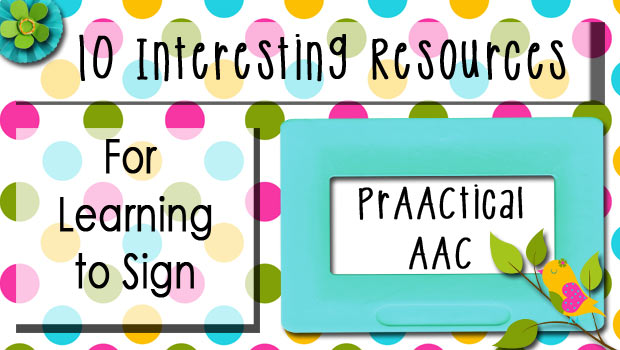
1. My Smart Hands has resources on their website and also a sign dictionary app. (There’s a Lite version, too.) 2. Sign to Talk: ASL signs (150 nouns and 40 verbs) 3. ASL Dictionary: Over 4800 ASL signs 4. Sign 4 Me: Translates from English to Signed English, ASL 5. iASL: Conversion from English to ASL 6. ASL Lite: Free Android app with 100 ASL signs 7. iSign: 800+ ASL phrases 8. Signing Time Lite: Free flashcard-type app for teaching signs to young children 9. Sign Me a Story: Signed stories for little kids 10. Baby Sign and Learn: Free app for teaching signs to young children. Choose from various sign languages: American Sign Language (ASL), Australian Sign Language (Auslan), British Sign Language (BSL), Hong Kong Sign Language (HKSL) and New Zealand Sign Language (NZSL). – –
April 24, 2012
by Carole Zangari -
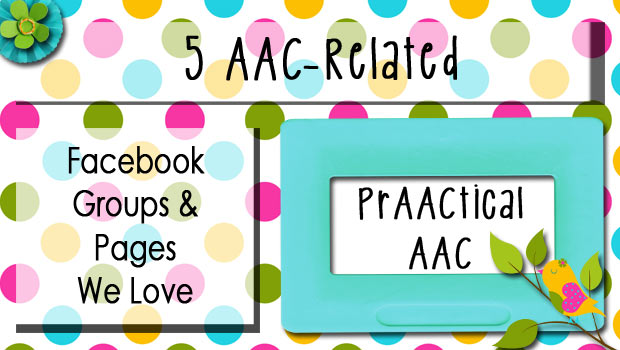
– We’re still getting used to the whole idea that social media sites, like Facebook and Twitter, can play such a powerful role in professional development. In addition to our our very own Facebook page, we, regularly visit a number of others for AAC and related content. – Augmentative Communication Resources and Help Boardmaker Sharing Group Raising and Teaching Individuals with Severe Disabilities Assistive Technology Technology in Education – How about you? What Facebook groups/pages do you find helpful? –
April 11, 2012
by Carole Zangari -
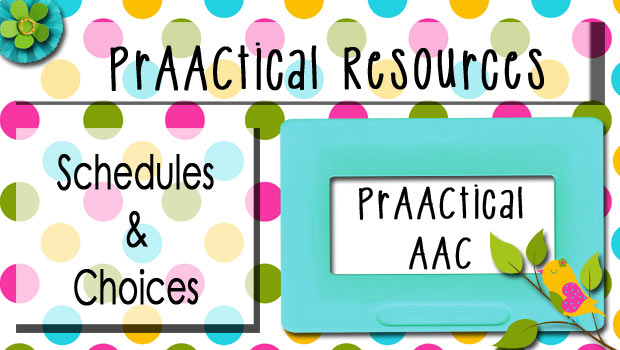
– If you follow our blog, you know that last month we had lots to say on making, teaching, and using Visual Schedules. We ran out of time before we could discuss a question that comes up a lot in our own clinical practice. What role does choice-making play in visual schedules? Here are some of the things we think about when we consider this for the schedules we make and use. We all like to have some say in what we do. Giving the learner an opportunity to make choices in a schedule makes sense when personal autonomy is a priority. Allowing the learner to choose which activities to place on the schedule supports personal autonomy: Having control over what happens in our lives is a big part of happiness for most people. – Here’s how we might do that with a visual schedule for a therapy session. 1.Select... [Read More...]
April 7, 2012
by Robin Parker -
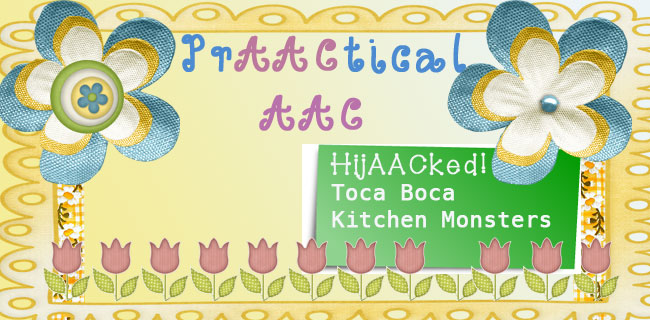
Toca Boca App Developers make general education preschool apps. They are dedicated to providing interactive play opportunities using mobile technology. We have loved every one of their apps since we first saw them. There seems to be some philosophical similarities between the Toca Boca Apps and so we will begin with why we love ALL of them. We have found them to be engaging to all ages (including us). They also provide practice and interaction with life experiences in a fun and pretend tech way. We love the beautiful artwork. We love that they are reasonably priced, often participate in ‘give aways’ and they even do free GIFTS (think Toca Hair Salon Christmas Gift and now Toca Kitchen Monsters). We use these apps so often that we can say we have officially HijAACked them for PrAACtical AAC. We have HijAACked ALL of these apps to use with AAC... [Read More...]
April 7, 2012
by Carole Zangari -
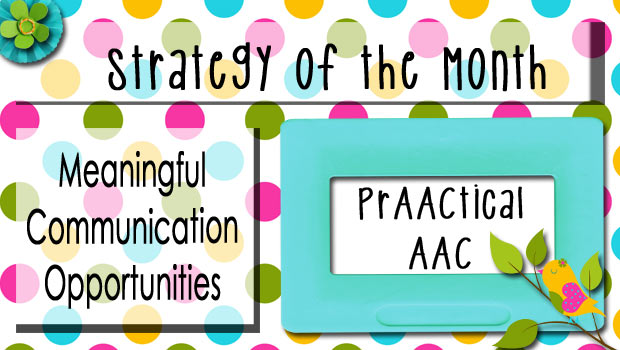
April is springtime where we live and spring is a time of beginnings. It’s fitting, then, that our AAC strategy of the month speaks to the very beginning of AAC intervention. Learning how to create focused opportunities to teach or practice an AAC skill is a pivotal skill for SLPs. The concept is a simple one: create an environment in which the learner WANTS or NEEDS to display the target skill. – Communication opportunities are related to the concept of communicative temptations. As SLP blogger Becca Jarzynski of Child Talk puts it “Communication temptations are pretty much just what they sound like: we set up the environment to tempt children to communicate with us.” Stop by and read her excellent post here . While Becca focuses on their use with young children, the approach can be used with people of any age. – Tempting people to communicate is all about... [Read More...]
April 1, 2012
by Carole Zangari -
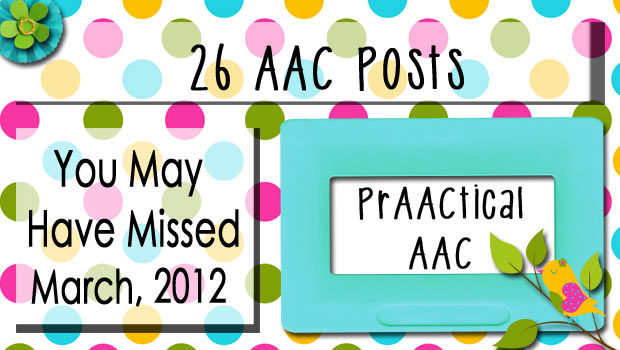
If March was as busy for you as it was for us, then you may have missed some of these posts. Grading exams, meeting with students, clinical paperwork, grant-writing, teaching, travel, etc. Know wonder we’re tired! Enjoy this bit of catch-up. – The Fives 5 Great Resources for Helping Individuals with Vision and Hearing Loss AAC on the Go: 5 Tips for Traveling with AAC Tech it Up’- 5 Visual Schedule Apps 5 Resources for AAC Data Collection 5 Tips to Make AAC Assessments Run Smoothly 5 References to Support AAC Use – PrAACtical Thinking 1. The Secret to Succeeding At Anything 2. National Quilting Day & Employment 3. AAC and March Madness 4. Games are More Than Fun… Gaming for ALL 5. Hearing the Knock 6. HijAACked! AAC & Anti-Bullying with Stand Tall, Mary Lou Melon! 7. Emergencies and Resources to Help 8. Random Acts of Kindness 9. Do... [Read More...]
March 31, 2012
by Carole Zangari -
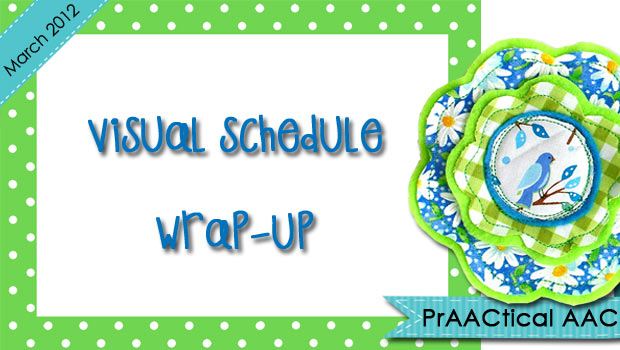
In this last post on our March Strategy of the Month, visual schedules, we address a couple of questions about using schedules and end with a list of helpful resources. Lots to click on and explore! – What about activities that don’t happen very often? How do we incorporate those into the schedule? Many of the learners with whom we work get quite stressed when the typical routine is violated. It could be an undesired change, like a fire drill or a dentist appointment. Or it could be that a regular event gets cancelled, such as when our music therapist is out sick or when outdoor recess is cancelled due to bad weather. Even changes that involve the addition of a positive event, such as a birthday party or a special classroom guest, could lead to stress and meltdown. If we have advance notice of the change, we can use... [Read More...]
March 15, 2012
by Carole Zangari -
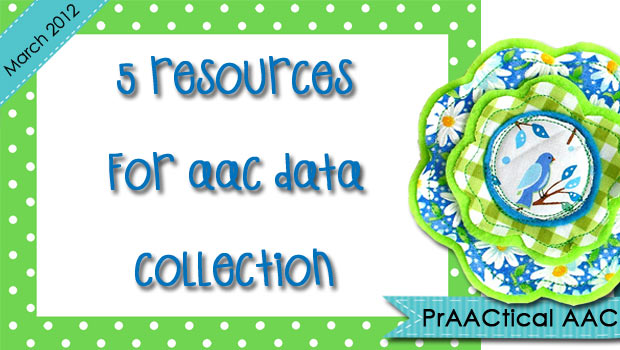
We’re big fans of AAC devices and apps that help with data collection. When used with appropriate attention to confidentiality issues (e.g., client consent, etc.) they can help SLPs gather data on how language is used under real-world conditions. When the data are interpreted skillfully, these are wonderful clinical resources that can help us adjust our intervention plans to accelerate learning. – Many times, however, we’re also looking for data collection tools that are separate from the AAC tool itself. – Here are some ideas for forms and tools for collecting data that help us plan better intervention. – 1. The book How Do You Know It? How Can You Show It? Making Assistive Technology Decisions (Reed, Bowser, & Korsten, 2002) has a good overview of concepts in data collection in AT and helpful forms. You can get a PDF of that book here. 2. The blog Teaching Learners... [Read More...]
March 13, 2012
by Carole Zangari -
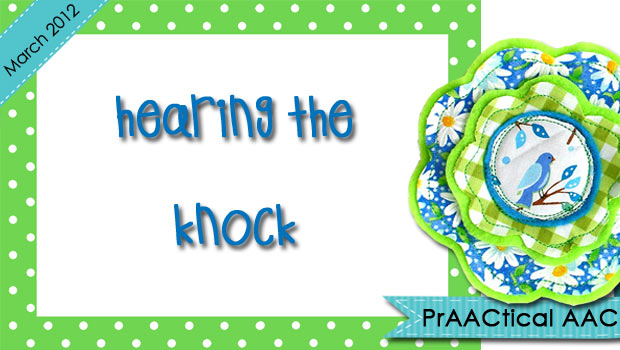
Wishes are wonderful things, seducing us with their promise and possibility. So with the luck o’ the Irish in mind, we’re sending forth a wish for something intangible, the big O: Opportunity. — Our AAC wish list for this month is all about opportunities. Opportunity. It has such a nice ring to it. Our parents and teachers tried to prepare us to recognize opportunity, and promised us that it would come knocking. – But sometimes the knock of AAC opportunity is drowned out by other things. Sometimes we just don’t hear it. We may miss the opportunity to teach a new clinician how to expand the language of a teenager learning to use a speech generating device. We may miss the chance to create the teachable moment for a child just learning to use AAC to make a comment. We might miss the opportunity to encourage a parent to give... [Read More...]
March 3, 2012
by Carole Zangari -

Here’s a riddle for you. Read the clues and guess what tool or strategy we’re talking about. Clue #1: It’s used in almost every classroom and therapy room serving students with ASD. Clue #2: The one for Johnny looks almost the same as the one for Jenny. Clue #3: It looks as nice in June as it did in September. If you guessed visual schedules, you’ve just named our March Strategy of the Month. Visual Schedules? But everybody already uses those. Why post about those? — Here’s why. – They’re ubiquitous. And yet when we talk with educators and SLPs about how the children are doing with their schedules, we get a look and a shrug. “Okay, I guess.” To be sure, okay is better than not okay. But visual schedules have so much potential to make lives better for clinicians, educators, and people with AAC needs that okay isn’t... [Read More...]









